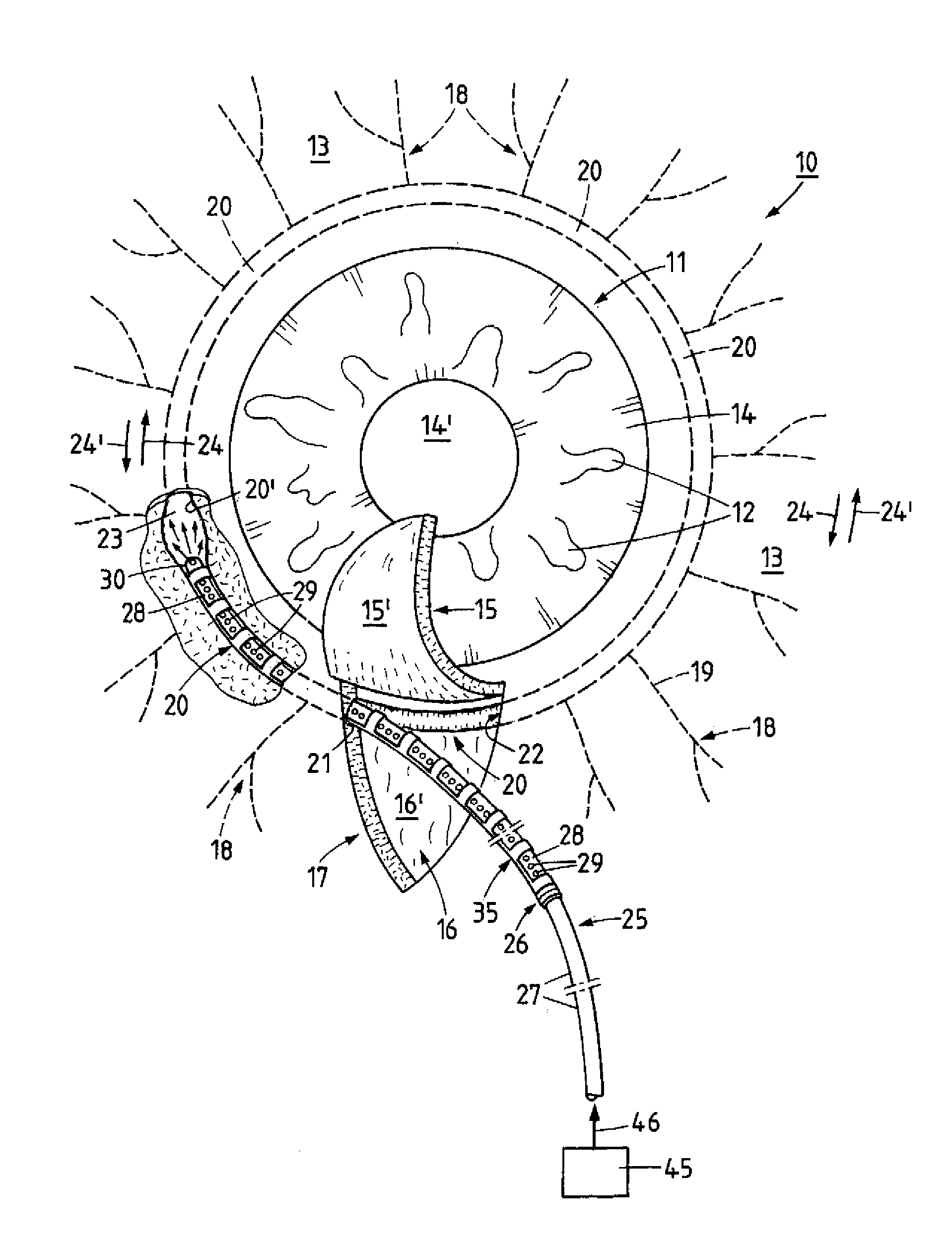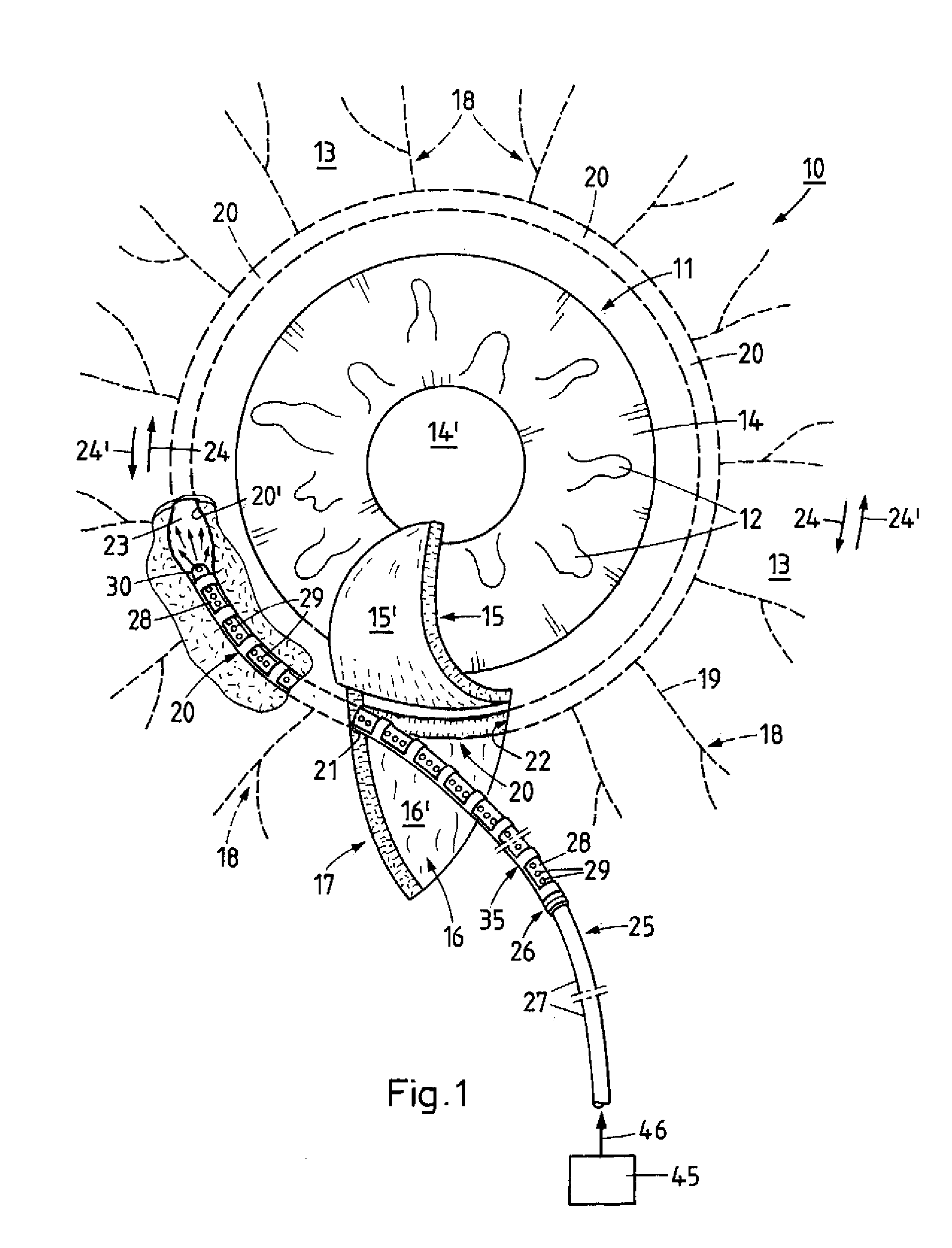Method and device for the treatment of glaucoma
a glaucoma and treatment method technology, applied in the field of glaucoma treatment methods and devices, can solve the problems of most temporary effects, and achieve the effect of reliable natural regulation of eye inner pressur
- Summary
- Abstract
- Description
- Claims
- Application Information
AI Technical Summary
Benefits of technology
Problems solved by technology
Method used
Image
Examples
first embodiment
[0039]FIG. 3 shows the implant 35 made from an elongated flexible tube 36. The implant 35 is of a configuration that includes a connecting part 35b continuously extending in axial direction along a longitudinal axis Z with a substantially circular-shaped cross sectional profile, and disposed thereon several ring members 35c spaced apart by recesses 35a. The circular interior space 35e of the connecting part 35b flanked by the ring members 35c, is constructed for receiving the tube-shaped distal portion 28 of the catheter 25.
[0040]The length L of the implant 35 corresponds either to the location of the afflicted site or corresponds to a distance extending from the first opening 21 to the second opening 22 of the circumference of the Schlemm's canal 20. The circular Schlemm's canal 20 has a diameter approximately from 10.0 mm to 12.0 mm which is preferably determined prior to the surgical procedure for the respective eye 10, and computed in dependence on the entire extension of the le...
second embodiment
[0042]FIG. 5 shows an example of an implant 35 made form a flexible elongated tube 36 and in the direction of longitudinal axis Z, two diametrically opposed connection parts 35b as well as several ring members 35c in direction of the longitudinal axis Z and distanced from each other by recesses 35a. The recesses 35a each respectively connect to the interior 35e and are configured in rectangular shape in this embodiment. However, the recesses 35a can also be of an oval, elliptical, square or trapezoidal shape. The length L of the implant 35 according to FIG. 5 is computed analog implant 35 as described in connection with FIG. 3.
[0043]FIG. 6 shows the cross section of the profile of the circular ring-shaped implant 35 according to the section line B-B in FIG. 5, where the two connecting parts 35b are shown disposed diametrically opposite relative to each other and in direction of the longitudinal axis. In one of the connecting parts 35b, the slot-shaped gap 35d oriented in direction o...
third embodiment
[0056]FIG. 12 shows a top view of the implant 35 made from the elongated flexible tube 36. The implant 35 includes the connection part 35b which extends along the longitudinal axis Z and has a substantially circular cross section, as well as the ring parts 35c that are spaced apart by the recesses 35a. The connection part 35b and the ring parts 35c having interior space 35e are constructed for receiving the tube-shaped distal portion 28 of catheter 25 (FIG. 9).
[0057]The ring parts 35c which are spaced apart by recesses 35a and disposed at tube 36 maybe also, as schematically illustrated in FIG. 12, disposed in grouped and in axial disposition of two or more ring parts 35c at any location at the implant 35.
[0058]In a variant to the first embodiment (FIG. 3) of implant 35, the ring parts 35c in the embodiment according to FIG. 12 are formed by a first ring member 35c′ and a second ring member 35c″ which meet at a Z-shaped gap. The approximately semi-circular shaped ring members 35c′ a...
PUM
 Login to View More
Login to View More Abstract
Description
Claims
Application Information
 Login to View More
Login to View More - R&D
- Intellectual Property
- Life Sciences
- Materials
- Tech Scout
- Unparalleled Data Quality
- Higher Quality Content
- 60% Fewer Hallucinations
Browse by: Latest US Patents, China's latest patents, Technical Efficacy Thesaurus, Application Domain, Technology Topic, Popular Technical Reports.
© 2025 PatSnap. All rights reserved.Legal|Privacy policy|Modern Slavery Act Transparency Statement|Sitemap|About US| Contact US: help@patsnap.com



